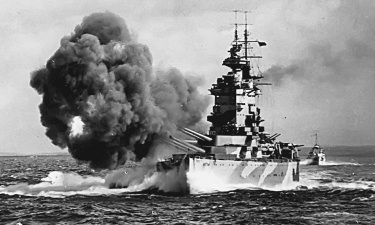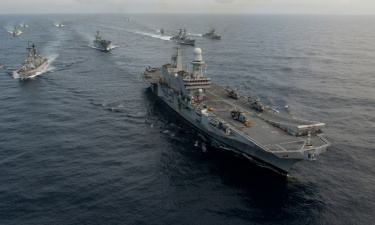Although it has never aspired to become a major global navy, the Italian fleet has traditionally intended to dominate the one sea where most of its geopolitical interests lie: the Mediterranean. Defeat in World War II left the navy in dire shape but it has since modernized to become an important asset for NATO, with particularly close ties in terms of cooperative ship development to its former rival France.
The Regia Marina was moderately sized at the outbreak of World War I with a handful of dreadnoughts and benefitting from the support of the far larger French and British fleets which dominated the Mediterranean. At sea as it was on land, Italy's main foe was Austria-Hungary but a major clash between the two battlefleets never materialized. Nevertheless, there was considerable smaller scale naval activity in the Adriatic between the two rivals with the Italians being particularly effective at unconventional tactics such as the use of small torpedo boats and human torpedoes.
The 1922 Washington Naval Treaty was a huge win for Italy as it allowed it parity with its regional rival, France. Benito Mussolini had big ambitions to turn the Mediterranean into an Italian lake which led to a vast expansion of the navy which at the time of its entry in World War II had sizeable cruiser, destroyer, and submarine fleets as well as two of the best battleships in Europe in the form of the Littorio-class. But even though it benefitted from France’s surrender as well as from German air and submarine power, the Italian navy struggled against the superior tactics and technology of the Royal Navy which despite being outnumbered and suffering heavy losses of its own, managed to prevent the Italian navy from ever establishing control in its Mare Nostrum. Particularly humiliating was the daring British aircraft carrier attack on Italy's naval base at Taranto in November 1940 which put half its battlefleet out of action, as well as attacks on Italy's merchant ships and transports which heavily contributed to the defeat of Axis forces in North Africa.
Italy’s surviving fleet served as the groundwork for its evolution into a smaller but effective Cold War navy, primarily based around anti-submarine warfare. More recently, the Marina Militare (as it has been known since the end of the monarchy) has also established a naval air arm based around the Garibaldi and Cavour-class light carriers. Close cooperation with France has also led to numerous joint designs including the Orizzonte-class air defense destroyers and the FREMM family of frigates. With Fincantieri evolving to become Europe’s largest shipbuilder, Italy will have no shortage of capabilities and resources to remain at the forefront of naval development at a global level.
The Regia Marina was moderately sized at the outbreak of World War I with a handful of dreadnoughts and benefitting from the support of the far larger French and British fleets which dominated the Mediterranean. At sea as it was on land, Italy's main foe was Austria-Hungary but a major clash between the two battlefleets never materialized. Nevertheless, there was considerable smaller scale naval activity in the Adriatic between the two rivals with the Italians being particularly effective at unconventional tactics such as the use of small torpedo boats and human torpedoes.
The 1922 Washington Naval Treaty was a huge win for Italy as it allowed it parity with its regional rival, France. Benito Mussolini had big ambitions to turn the Mediterranean into an Italian lake which led to a vast expansion of the navy which at the time of its entry in World War II had sizeable cruiser, destroyer, and submarine fleets as well as two of the best battleships in Europe in the form of the Littorio-class. But even though it benefitted from France’s surrender as well as from German air and submarine power, the Italian navy struggled against the superior tactics and technology of the Royal Navy which despite being outnumbered and suffering heavy losses of its own, managed to prevent the Italian navy from ever establishing control in its Mare Nostrum. Particularly humiliating was the daring British aircraft carrier attack on Italy's naval base at Taranto in November 1940 which put half its battlefleet out of action, as well as attacks on Italy's merchant ships and transports which heavily contributed to the defeat of Axis forces in North Africa.
Italy’s surviving fleet served as the groundwork for its evolution into a smaller but effective Cold War navy, primarily based around anti-submarine warfare. More recently, the Marina Militare (as it has been known since the end of the monarchy) has also established a naval air arm based around the Garibaldi and Cavour-class light carriers. Close cooperation with France has also led to numerous joint designs including the Orizzonte-class air defense destroyers and the FREMM family of frigates. With Fincantieri evolving to become Europe’s largest shipbuilder, Italy will have no shortage of capabilities and resources to remain at the forefront of naval development at a global level.
There are currently 98 entries, data on 0 warship types, and 609 individual warships in the registry.

The formidable Littorio battleships were not enough to defeat the Royal Navy in the Mediterranean.

The modern Italian navy is a well-rounded force with many technologically-advanced designs.